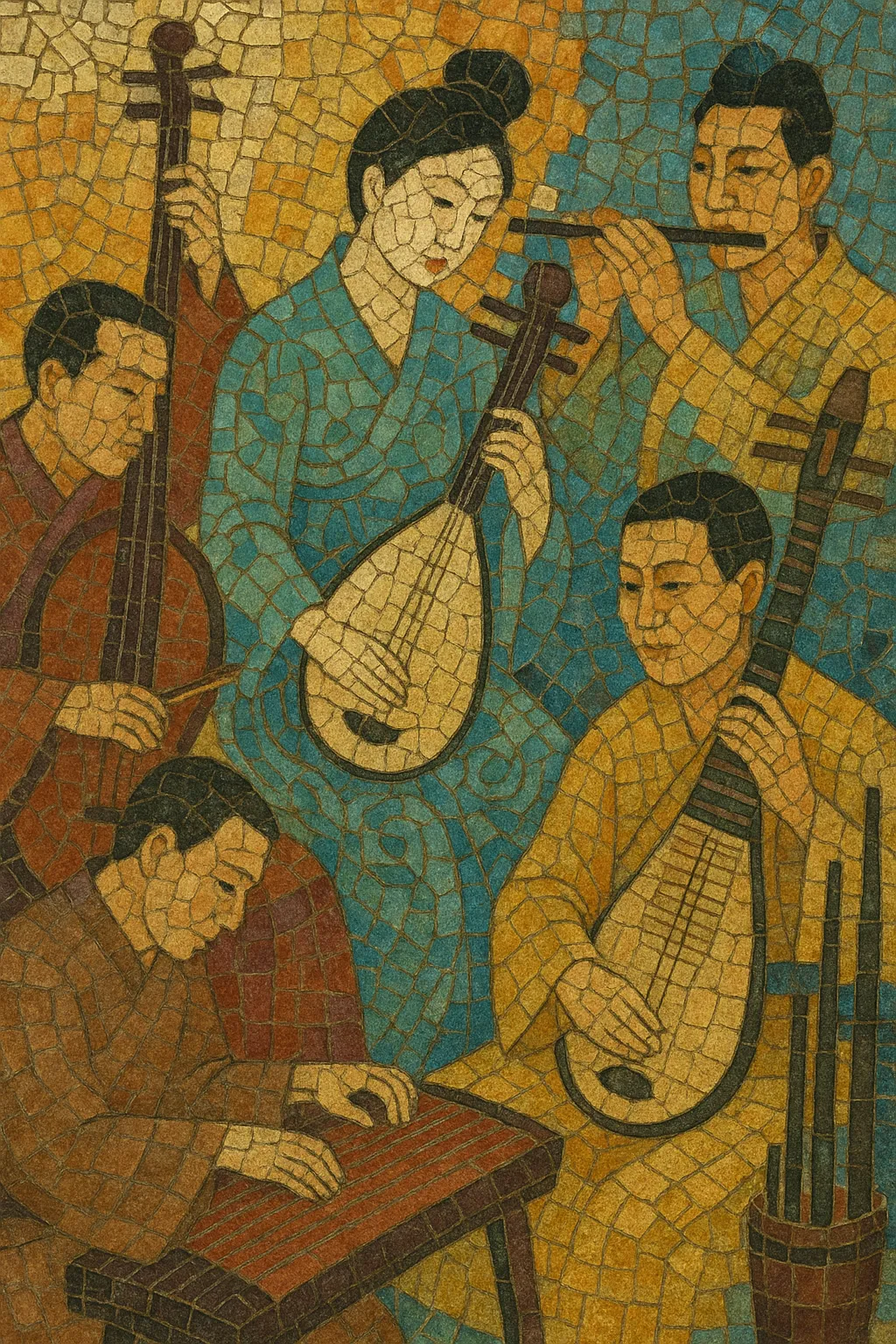Guoyue (literally “national music”) is a modern umbrella for Chinese traditional instrumental music and its 20th‑century orchestral reinvention. It centers on indigenous instruments—such as erhu, pipa, dizi, guzheng, yangqin, suona and sheng—organized into standardized sections (bowed strings, plucked strings, winds and percussion) to form the Chinese orchestra.
Stylistically, guoyue draws on pentatonic modal systems (gong, shang, jue, zhi, yu), heterophonic textures, flexible tempi and ornate timbral inflections (glissandi, portamenti, grace‑note ornaments, vibrato types). Since the mid‑20th century it has also absorbed Western techniques—symphonic forms, counterpoint, functional harmony and programmatic writing—while retaining unmistakable Chinese melodic contours, idiomatic ornamentation and characteristic instrumentation.
Today, guoyue encompasses solo and chamber traditions, large Chinese orchestras, and new concert works. It also informs film/TV scoring and crossover projects, and inspires pop idioms branded as “zhongguo feng,” in which traditional colors meet contemporary production.
The term guoyue gained currency in the early 20th century amid the New Culture/May Fourth movements, as musicians sought to modernize and codify Chinese musical heritage. In cosmopolitan Shanghai and other urban centers, traditional ensembles (e.g., Jiangnan sizhu) were adapted for concert presentation. Innovators like Liu Tianhua authored foundational erhu works, promoted numbered notation (jianpu) and advanced pedagogy, laying a modern repertoire and technique base.
After 1949, state ensembles and conservatories in mainland China formalized the Chinese orchestra, standardizing tuning systems, extending instrument families (e.g., gaohu, zhonghu, bass suona), and developing modern orchestration practices. Conductors/arrangers such as Peng Xiuwen created suites and symphonic poems from folk sources and regional opera tunes. While repertoire during certain periods reflected prevailing ideological themes, the era cemented ensemble structure, training pipelines and nationwide audiences.
Parallel developments in Taiwan and Hong Kong built professional orchestras, conservatory programs and competitions, cultivating both preservation (nanguan/beiguan) and new compositions for modern Chinese orchestra.
Post‑reform decades saw an explosion of concertos, tone poems and experimental works that integrated Western harmony, counterpoint, extended techniques and contemporary forms, while reaffirming traditional modal language and ornamentation. International soloists and ensembles toured widely, and film/TV scores popularized the sound world for new audiences. In the 2000s, crossover with pop and electronic production flourished, feeding “zhongguo feng” aesthetics and world‑fusion collaborations, even as conservatories continued to expand the art music repertoire.
Guoyue now spans solo recital traditions, chamber groups and large orchestras, with active commissioning, competitions and cross‑strait exchange. Its toolkit—pentatonic modality, heterophony, idiomatic ornament and distinctive timbres—remains intact, even as composers explore minimalist pulses, cinematic textures and hybrid electro‑acoustic orchestrations.
Start with pentatonic modes (gong, shang, jue, zhi, yu). Treat mode as a tonal center with characteristic scale‑degrees and cadential tones. Use modal shifts by reinterpreting the gong (tonic) or borrowing degrees from related modes. Favor conjunct, singable melodies with clear phrase shapes.
Heterophony is core: multiple instruments render the same melody with idiomatic ornaments and slight rhythmic inflections. When adding Western harmony, keep it light and coloristic—open fifths, parallel fourths, pentatonic planing and triadic pads under a modal lead. Countermelodies in ruan/pipa or sheng can enrich without crowding the primary tune.
Balance bright timbres (dizi, suona, pipa) with warm sustain (zhonghu, sheng, ruan). Double melodies across families for heterophonic richness.
Alternate free‑tempo introductions (sanban) with metered sections (erban). Common meters are duple/quadruple; incorporate additive patterns and dance rhythms from regional folk sources. Forms include qupai variations, rondo‑like suites, or programmatic arches (A–B–A′ with developmental middle).
Write idiomatic turns: slides, mordents, acciaccaturas, measured tremolo (pipa), rolling glissandi (guzheng), finger vibrato and portamento (erhu), flutter/tongue trills (dizi), grace‑note clusters (suona). Keep ornaments integral to melody, not mere decoration.
Compose in numbered notation (jianpu) for performers’ comfort; provide staff notation as needed. Indicate ornaments with standard guoyue symbols and articulate percussion cues clearly. When integrating Western harmony, ensure modal integrity of lead lines and avoid over‑chromaticism that obscures the pentatonic profile.
Use room or hall reverb to preserve natural resonance; avoid heavy compression that flattens dynamic swells. Workshop ornaments and rubato with principal players; encourage sectional heterophony rather than strict unison, especially in repeats or returns.


